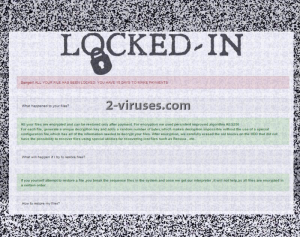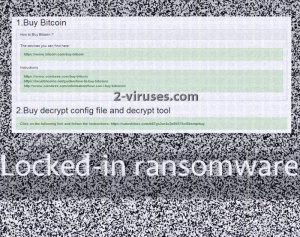Locked-in virus is not a threat that security researchers have to focus on anymore. Why? This version was discovered to be not too complicated since a free application for decryption was designed. Victims can download the constructed tool and restore encoded files that are appended with .novalid extension. Attention that crypto-ransomware viruses receive is gradually growing as Internet users are jeopardized by innovative versions of these persistent infections. Almost every day is marked with a newly discovered sample that encrypts files and demands a fee for questionable decryption. A common AES cipher for complex encryption is chosen by Locked-in crypto-virus. After this sophisticated encoding corrupts files and users can no longer access them, the ransomware virus senses a privilege to demand a solid ransom for the restoration of data.
Processes that Locked-in virus initiates
Locked-in virus cannot bear the though of letting people off the hook. Therefore, we guess that the creation of a free decryption software was a real tragedy for them. How can it not, when their mission of infecting people and encrypting their files is up to no good now, when victims are in no way obligated to purchase BTC and send them to the unreliable hackers. On a different note, Locked-in virus is not completely identical to the preceding ransomware viruses. This specific variant has a couple of features that single it out from the crowd. It gives people 15 days to make a payment which is considerably a long period of time. Ironically, security researchers were quicker to produce a genuine tool for decryption. As the ransom note indicates, Locked-in virus proceeds with AES-256 cipher which is not an irregular selection. Nevertheless, before the encryption process can be fully implemented, ransomware virus has to make progress in smaller objectives.
Upon the arrival of Locked-in virus, or more specifically, its payload, infected devices are going to go through a series of modifications. At first, virus will secretively add new registry keys. Because of this alteration, payload of the virus will automatically launch and run in the background as you continue with your regular procedures. After files for encryption are selected, Locked-in virus will use AES-256 cipher on them. This means that your valuable data will ruined. But do not worry! There is no reason to panic as security researchers’ efforts were not wasted. They managed to create a program for decryption of the files which can be downloaded free-of-charge. You can download the software by clicking here.
Decryption of encrypted files and tricks to obviate infections like Locked-in virus
We have already explained the easiest way to decrypt files that Locked-in virus has ruined. For this reason, there is no reason to pay the demanded fee. However, not all ransomware viruses are sorted out this quickly. Some fights last for months and years. That is why it would be best to become completely immune to ransomware infections. People might be convinced to pay the ransom because their valuable data has been corrupted? Then, you should create copies of files and stored them in USB flash drives or online storing facilities. This would mean that in an unfortunate event of an infection with a ransomware virus, you won’t have to distress about your data as you will be able to easily retrievable it from other sources.
Transmission of Locked-in virus payload
However, simply becoming infected with ransomware viruses might be indicated as a real inconvenience. For this reason, people are advised to keep their email accounts spam-free as many campaigns are initiated to spread ransomware viruses. Locked-in virus can also be transmitted via infectious email letters. If you receive messages that are allegedly addressing crucial issues, make sure that the letter looks legitimate. Hackers are usually sloppy in designing infectious letters: fake email addresses are funny-looking, even titles are written with errors or inconsistencies.
To remove Locked-in virus from your device, you can follow our instructions for a manual removal or utilize a reliable anti-malware tool which will detect all of the problems, present in your device. Spyhunter or Hitman will surely treat your device with respect and care.
Update of the 13th of December, 2016. Download Locked-In ransomware decrypter here.
Locked In Virus quicklinks
- Processes that Locked-in virus initiates
- Decryption of encrypted files and tricks to obviate infections like Locked-in virus
- Transmission of Locked-in virus payload
- Automatic Malware removal tools
- How to recover Locked-in virus encrypted files and remove the virus
- Step 1. Restore system into last known good state using system restore
- 1. Reboot your computer to Safe Mode with Command Prompt:
- 2.Restore System files and settings.
- Step 4. Use Data Recovery programs to recover Locked-in virus encrypted files

Automatic Malware removal tools
(Win)
Note: Spyhunter trial provides detection of parasites and assists in their removal for free. limited trial available, Terms of use, Privacy Policy, Uninstall Instructions,
(Mac)
Note: Combo Cleaner trial provides detection of parasites and assists in their removal for free. limited trial available, Terms of use, Privacy Policy, Uninstall Instructions, Refund Policy ,
How to recover Locked-in virus encrypted files and remove the virus
Step 1. Restore system into last known good state using system restore
1. Reboot your computer to Safe Mode with Command Prompt:
for Windows 7 / Vista/ XP
- Start → Shutdown → Restart → OK.
- Press F8 key repeatedly until Advanced Boot Options window appears.
- Choose Safe Mode with Command Prompt.

for Windows 8 / 10
- Press Power at Windows login screen. Then press and hold Shift key and click Restart.

- Choose Troubleshoot → Advanced Options → Startup Settings and click Restart.
- When it loads, select Enable Safe Mode with Command Prompt from the list of Startup Settings.

2.Restore System files and settings.
- When Command Prompt mode loads, enter cd restore and press Enter.
- Then enter rstrui.exe and press Enter again.

- Click “Next” in the windows that appeared.

- Select one of the Restore Points that are available before Locked-in ransomware has infiltrated to your system and then click “Next”.

- To start System restore click “Yes”.

Step 2. Complete removal of Locked-in virus
After restoring your system, it is recommended to scan your computer with an anti-malware program, like Spyhunter and remove all malicious files related to Locked-in ransomware. You can check other tools here.Step 3. Restore Locked-in virus affected files using Shadow Volume Copies
If you do not use System Restore option on your operating system, there is a chance to use shadow copy snapshots. They store copies of your files that point of time when the system restore snapshot was created. Usually Locked-in ransomware tries to delete all possible Shadow Volume Copies, so this methods may not work on all computers. However, it may fail to do so. Shadow Volume Copies are only available with Windows XP Service Pack 2, Windows Vista, Windows 7, and Windows 8. There are two ways to retrieve your files via Shadow Volume Copy. You can do it using native Windows Previous Versions or via Shadow Explorer. a) Native Windows Previous Versions Right-click on an encrypted file and select Properties → Previous versions tab. Now you will see all available copies of that particular file and the time when it was stored in a Shadow Volume Copy. Choose the version of the file you want to retrieve and click Copy if you want to save it to some directory of your own, or Restore if you want to replace existing, encrypted file. If you want to see the content of file first, just click Open.
b) Shadow Explorer It is a program that can be found online for free. You can download either a full or a portable version of Shadow Explorer. Open the program. On the left top corner select the drive where the file you are looking for is a stored. You will see all folders on that drive. To retrieve a whole folder, right-click on it and select “Export”. Then choose where you want it to be stored.

Step 4. Use Data Recovery programs to recover Locked-in virus encrypted files
There are several data recovery programs that might recover encrypted files as well. This does not work in all cases but you can try this:- We suggest using another PC and connect the infected hard drive as slave. It is still possible to do this on infected PC though.
- Download a data recovery program.
- Install and scan for recently deleted files.









